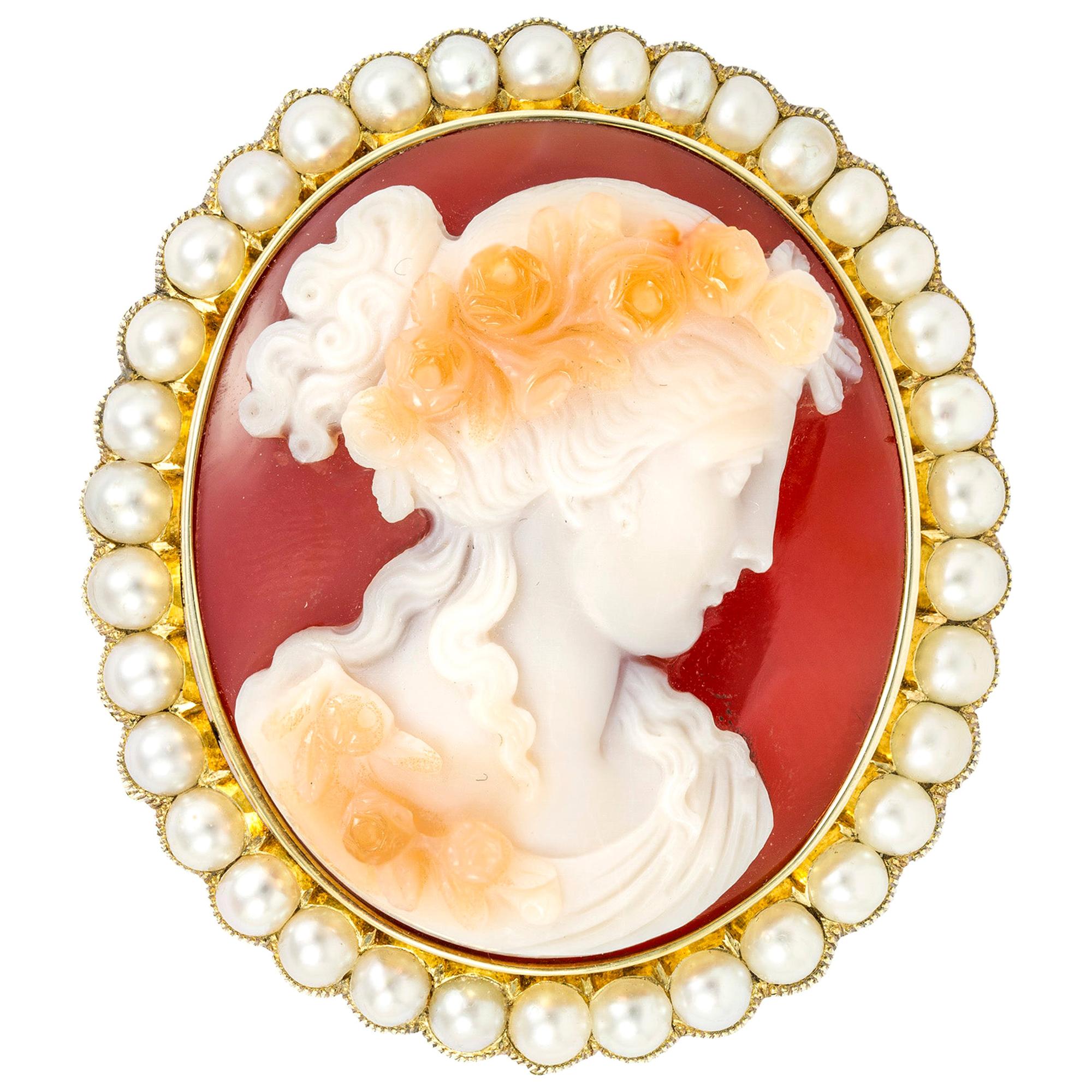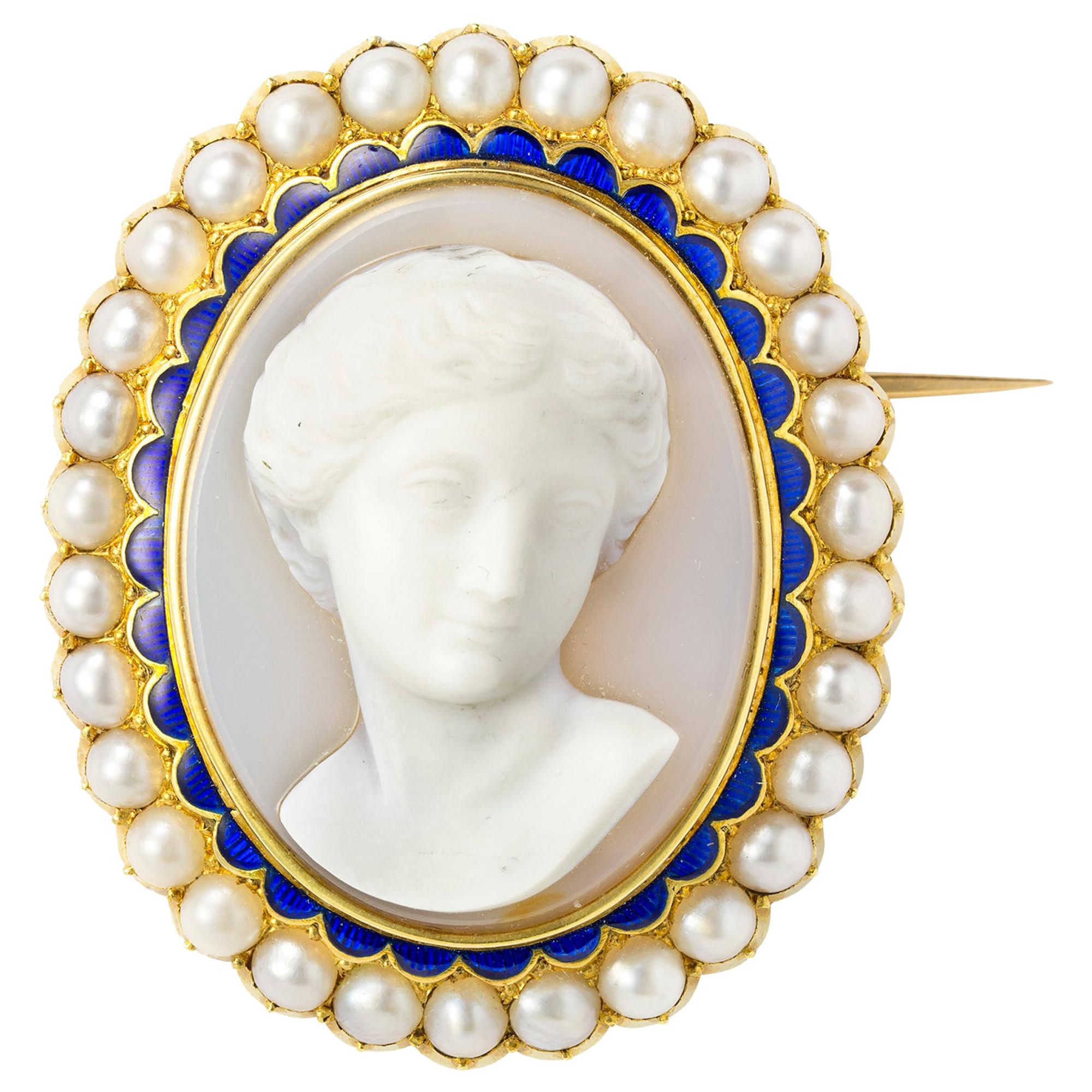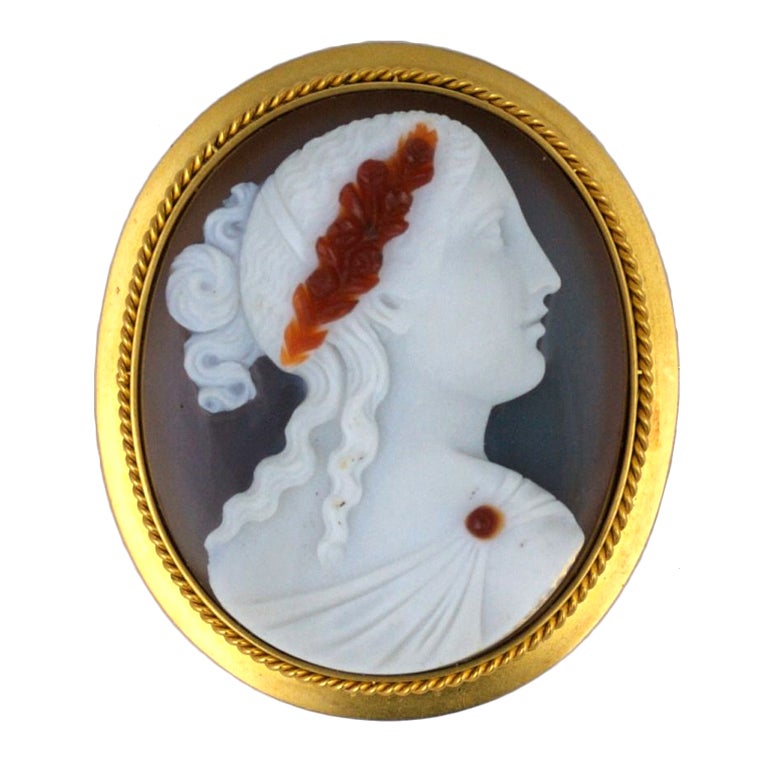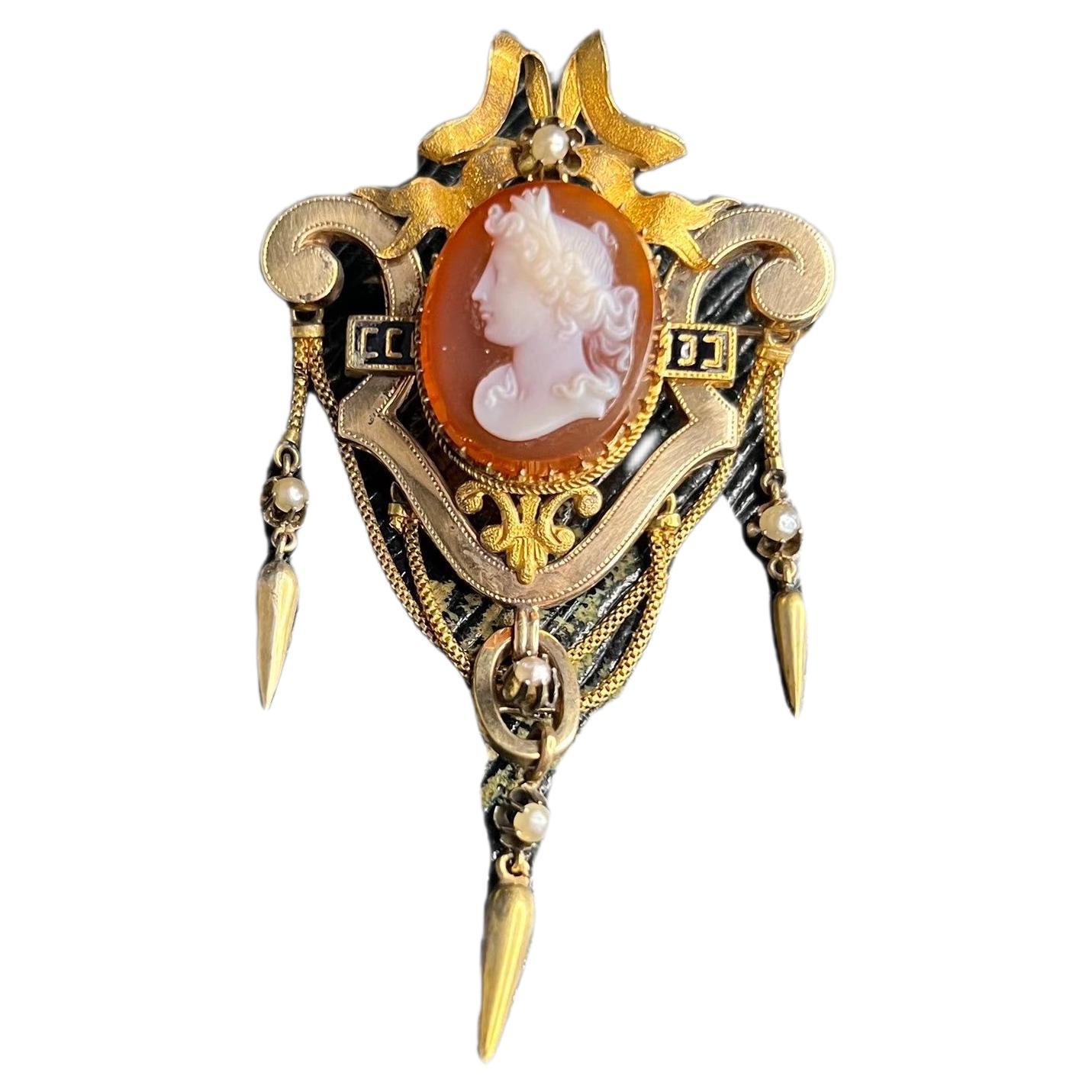Items Similar to Victorian hardstone cameo brooch, French, circa 1900
Video Loading
Want more images or videos?
Request additional images or videos from the seller
1 of 9
Victorian hardstone cameo brooch, French, circa 1900
About the Item
Victorian hardstone cameo brooch. Set with an oval cameo in hardstone depicting the profile of a woman in the classical style, featuring a decorative engraved border and fitted to reverse with secure hinge pin. Marked yellow gold, maker's mark 'PR', French, circa 1900.
- Metal:Yellow Gold
- Style:Victorian
- Place of Origin:Europe
- Period:1900-1909
- Date of Manufacture:1900
- Condition:Wear consistent with age and use.
- Seller Location:London, GB
- Reference Number:
About the Seller
5.0
Recognized Seller
These prestigious sellers are industry leaders and represent the highest echelon for item quality and design.
1stDibs seller since 2011
56 sales on 1stDibs
Typical response time: 3 hours
- ShippingRetrieving quote...Ships From: London, United Kingdom
- Return PolicyA return for this item may be initiated within 3 days of delivery.
More From This SellerView All
- Antique Cameo Brooch, circa 1850.Located in London, GBHardstone cameo brooch. Set with a carved hardstone cameo to centre of a bust of a lady in profile within a yellow gold ornate horizontal form, with gold wirework, floral beading and...Category
Antique 1850s Victorian Brooches
Materials18k Gold
- Victorian Diamond and Enamel Tiger Brooch, American, circa 1900Located in London, GBVictorian diamond and enamel tiger brooch. Set to centre with a round old cut diamond in a closed back claw setting, with an approximate weight of 0.20 carats, further set with two r...Category
Antique Early 1900s American Late Victorian Brooches
MaterialsDiamond, 14k Gold, Enamel
- Maison Plisson Et Hartz Chimera Brooch, French, circa 1900By Plisson et HartzLocated in London, GBMaison Plisson et Hartz chimera brooch. A circular yellow gold brooch, composed of an intricately carved crouching chimera with teeth bared and wings unfurled, encircled by a swirl o...Category
Antique Early 1900s French Gothic Revival Brooches
Materials18k Gold
- Maison Vever Paris Enamel and Gold Brooch French circa 1900.By VeverLocated in London, GBEnamel and gold brooch by Maison Vever Paris, French, circa 1900. An 18 carat yellow gold brooch in the form of a circular shallow concave disk decorated with a poppy, a daisy and a ...Category
20th Century French Edwardian Brooches
MaterialsYellow Gold
- Victorian diamond pendant/brooch, circa 1880.Located in London, GBVictorian diamond pendant/brooch. Centrally set with a cushion shape old mine diamond in an open back cut-down setting with an approximate we...Category
Antique 1880s Pendant Necklaces
MaterialsDiamond, Yellow Gold, Silver
- John Brogden Shell Cameo Brooch and Earrings, English, circa 1870By John BrogdenLocated in London, GBAntique shell cameo brooch and earrings by John Brogden, English, circa 1870. A yellow gold suite of jewellery, the brooch composed of a horizontally situated oval Bull’s Mouth shell cameo of the Greek goddess Selene riding a serpentine dragon in a rubover collet setting, encircled by a conforming frame of gold beading and twisted gold wire punctuated with four gold palmette form plaques engraved and decorated with dark blue enamel and placed at the cardinal points, the reverse mounted with a hinged pin and scroll clasp, the earrings each composed of a vertical oval Bull’s Mouth shell cameo engraved with a bust length portrait of Selene with crescent-set headdress, encircled by a conforming frame matching that of the brooch with the addition of a pendant decoration composed of a horizontal bar of gold beading and twisted gold wires suspending gold link chains graduated from centre and ending in conical gold elements, the reverses mounted with French wire fittings, all in a fitted red leather case, the interior marked ‘FIRST CLASS PARIS MEDAL/ 1855.1867.1851/ PARIS FIRST CLASS & LONDON PRIZE MEDALS/ JOHN BROGDON/ Goldsmith/ MANUFACTORY/ 16, Henrietta St. Covent Garden/ London’. The cameo—defined as a gem, usually either a mineral or a shell, upon which a design has been carved in relief—is believed to have originated in Hellenistic Greece, during the third century BC. These miniature sculptures, at that time confined to the medium of hardstone, are thought to have been made with the primary purpose of personal adornment. The same practice of mounting cameos in jewellery was then continued by the Ancient Romans, and they are known to have been worn by many a Roman emperor. After the fall of Rome the fashion for cameos went into a decline, until it was again revived during the Renaissance period, brought about by a keen interest in the ancient world. At this time both antique and contemporary cameos were mounted in jewellery, as well as collected as objet d’art. The art of cameo cutting was revived in Italy, where it would remain a centre for the coming centuries. Again there was a lull in interest in carved gemstones, until the Neoclassical revival of the eighteenth century, largely stimulated by the discoveries of the ancient Roman cities of Pompeii and Herculaneum. As with the Renaissance, antique specimens were generally prized over modern cameos, and the worldliest men in Europe held them among their collections of art and antiques. That said, carving centres in Rome and Torre del Greco (near Naples) in Italy were established in response to the demand of the Grand Tourists, who travelled to Italy and Greece to become educated in the wonders of the ancient world. It was at this time that shell cameos, mostly made in Torre del Greco due to its proximity to the sea, became more popular, owing to the relative ease in carving shell over hardstone. In addition to Rome, hardstone cameos also became a specialty of Idar Oberstein, Germany, which had a long history with both the gem mining and cutting trade. In a shift away from the collector’s cases of the previous century, the nineteenth century saw a strengthening in the fashion for wearable cameos. After the Empress Josephine donned a cameo-set suite of jewellery at the coronation of Napoleon in 1804, cameo jewellery became all the rage. Napoleon played a further hand in promoting the art by establishing a gemstone carving school in Paris, inspired by his appreciation for the arts of the ancient world. By the mid-nineteenth century shell cameos, in part due to their lightness compared with hardstone cameos, were the height of fashion. Large shell cameos as well as hardstone cameos were set into contemporary mounts, often as suites of jewellery. Some of the best cameos of the nineteenth century—carved by a select group of recognized carvers—were set into revivalist mounts, corresponding to the subject matter. In Victorian England cameo jewellery was particularly prized, due in part to the fact that the Queen owned and wore a number of cameo jewels. One example which can often be seen in official portraits is the Badge of the Order of Victoria and Albert, carved by Tommaso Saulini of Rome, who also produced cameos for the maker of the present suite, John Brogden. To meet demand some carvers set themselves up in London, including William Schmidt, a German carver from Idar Oberstein, who produced cameos for top London jewellers, including Brogden, Carlo Giuliano and Child & Child. In fact, Schmidt purports to have been the first to carve cameos out of opal, which Brogden reportedly displayed in the Paris Exhibition of 1878. An extant example, now in the collection of the British Museum, was set by the Giuliano firm. Regarding subject matter, cameos throughout time have been largely figural, from bust length profile portraits to scenes with multiple full-length figures, and sometimes animals. Ancient Greek and Roman cameos often depicted mythological scenes as well as contemporary figures. During the Renaissance, mythological scenes were popular, often taken directly from ancient sculpture, as well as portraits of notable contemporary figures. During the eighteenth and nineteenth centuries, due to the revivalist styles, both Renaissance and Classical subjects were copied and set into matching (and sometimes unmatching) revivalist mounts. From the Renaissance through the Victorian era, being able to recognize the source of the carving in a cameo was a mark of erudition, revealing in the wearer knowledge of Classical art. As mentioned, the present cameo parure...Category
Antique 1870s English Victorian Brooches
MaterialsYellow Gold
You May Also Like
- Victorian Hardstone Cameo BroochLocated in London, GBA Victorian hardstone cameo brooch, the hardstone cameo depicting a profile of lady in Roman style wearing rose wreath, surrounded by a thirty f...Category
Antique 1860s British Victorian Brooches
MaterialsAgate, Natural Pearl, Yellow Gold, 18k Gold
- Victorian Hardstone Cameo Brooch PendantLocated in London, GBA Victorian hardstone cameo brooch pendant with blue enamel and pearl surround, the hardstone cameo depicting a female face in the Roman style s...Category
Antique Mid-19th Century English High Victorian Brooches
MaterialsAgate, Pearl, 18k Gold, Yellow Gold, Enamel
- Victorian Hardstone Cameo Gold BroochLocated in Riverdale, NYVictorian high relief sardonyx cameo of maiden with hair wreath decoration. The wreath and dress closure are carnelian toned against her alabaster profile....Category
Antique Late 19th Century Italian Victorian Brooches
MaterialsAgate, 18k Gold
- A Victorian Carved Hardstone Cameo BroochLocated in London, GBA Victorian carved hardstone cameo brooch, the circular carved hardstone depicting Eros accompanied by a lion, surrounded by yellow gold frame with beaded openwork border, circa 1870...Category
Antique 19th Century English Victorian Brooches
Materials18k Gold
- Victorian Hardstone Cameo and 14Kt BroochLocated in Wheaton, ILThis is a stunning Victorian-era piece of jewelry that dates back to the year 1870. The 14Kt yellow gold and black/white hardstone cameo depicts a beautiful woman in profile and feat...Category
Antique Late 19th Century Victorian Brooches
Materials14k Gold, Yellow Gold
- Antique 15ct Gold Victorian Hardstone Cameo BroochLocated in Brighton, GBAntique Cameo Brooch 15ct Gold Circa 1870 Fabulous Victorian Carnelian Hardstone Cameo Brooch. Features a Bow Top & Black Enamel Detailing. Complete with Original Gold Torpedo & ...Category
Antique Late 19th Century English Victorian Brooches
MaterialsGold, 15k Gold
Recently Viewed
View AllMore Ways To Browse
Cameo French Brooch Victorian
Rose Gold Garnet And Diamond Brooch
French Bird Brooch
Diamond And Ruby Turtle
Austrian Garnet Brooch
Tiffany Key Pin
1940 English Dragon Signet Ring
Platinum Belle Epoch Brooch
Sapphire Dimond Flowers Brooch
Heart Diamond Brooch Antique
Magnificent Costume Jewels
Chanel Gold Tone Brooch
18 Gold Bird Brooch
Tiffany 14k Diamond
Fior Coat
Latest Brooches
Gripoix Flower Brooch
Frascarolo Brooch





